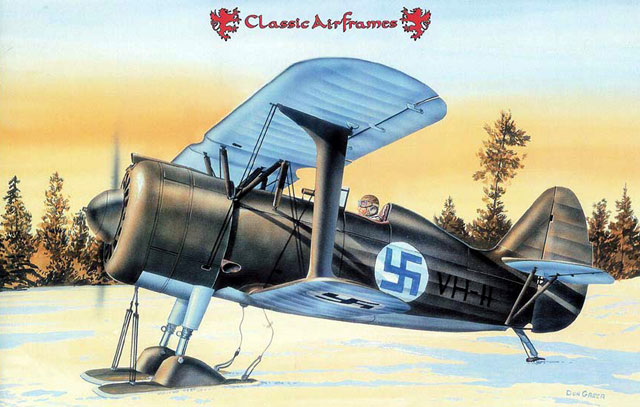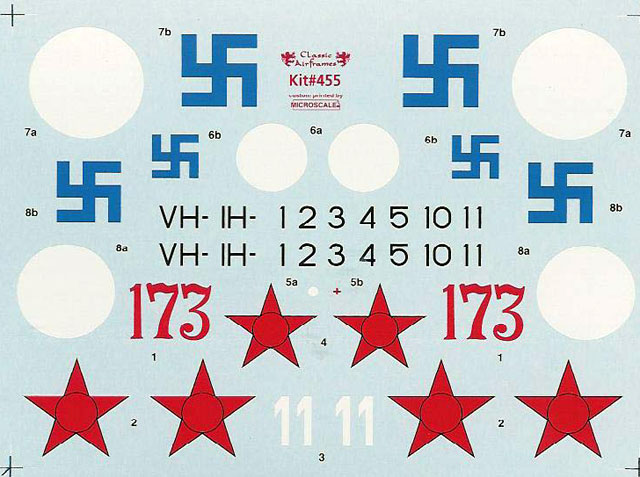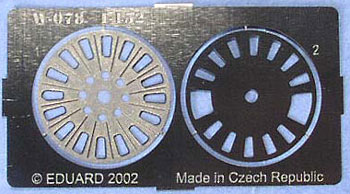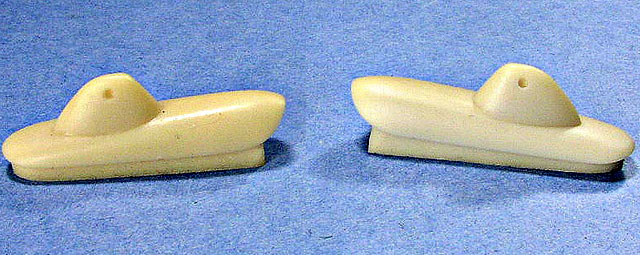|
Polikarpov I-152 (I-15 bis)

Classic Airframes
S
u m m a r y
|
| Catalogue Number
: |
455 |
| Scale: |
1/48 |
| Price: |
USD$39.95 RRP (USD $33.96 from Squadron.com) |
| Contents and Media: |
Low-pressure injection plastic - 43
grey styrene and 4 clear vacform windshields. 14 parts in pale
cream-colored resin. 2 etched metal parts. Decal sheet. Instructions and
painting guide for approximately 8 aircraft options. |
| Review Type: |
FirstLook |
| Advantages: |
Another minor player in the history
of aviation given its due, and in the markings of one of the smaller air
forces. Crisp, but restrained engraved pane lines and wing fabric and
ribbing; excellent resin parts with resin skis; clear parts to do two
different style windshields; excellent quality decals; clear instructions. |
| Disadvantages: |
Molding blocks on bottom of skis,
and flash on wings. |
| Recommendation: |
Highly Recommended for moderate to
experienced modelers who enjoy modeling the footnotes of WW-2 aviation. |
Reviewed by Steven Eisenman

Classic
Airframes' 1/48 scale Arado Ar 68 is available online from Squadron.com
The Polikarpov I-152 (AKA, I-15 bis) was a
continuation in the line of Polikarpov biplanes beginning with the I-5 and
ending with the I-153. It was an attempt to improve upon the I-15 by replacing
the upper gull wing of the I-15, which was complex to manufacture and restricted
the pilot’s vision, with the traditional biplane separate upper wing and improve
the engine performance. But the performance of the I-153 suffered in comparison
to the older I-15 as a result of increased weight.
The I-152 served with a number of combatant air forces, in addition to the
Soviet Air Force. During the Spanish Civil War, both the Republican and
Nationalist Air Forces used the I-152. So also did the Chinese Air Force and the
Finnish Air Force. As was often the case, the Finns received their Russian
aircraft as a result of capture following a forced landing. The Finns acquired
five I-152s and used them primarily as trainers.
Once again Classic Airframes takes a risk to
issue a kit that none of the larger main stream manufacturers would most likely
issue. The I-152 is boxed in two versions. The only difference between Kit No.
454 and 455 is that, for a few more dollars, Kit No. 455 comes with a lovely
pair of resin skis, and the appropriate markings. The marking included two
Russian aircraft in dark olive green over light blue-gray with the early style
black outlined red star with the inner black circle. One of these aircraft, red
173, was captured by the Finns and became VH-11 in the Finnish Air Force.
The Finnish markings will allow you to do a variety of aircraft. Although the
Finns only had five, they changed the markings and designations over time. You
can begin with VH-11 in plain dark olive green over light blue-gray and move on
to VH-4 or IH-5 in the same basic color, but with the addition of yellow
underside upper wing tips and fuselage band. Finally, there IH-2 in the classic
Continuation War color scheme of black, dark olive green, and blue-gray with the
yellow underside upper wing tips, fuselage band and cowl. On this last aircraft,
I do not know whether the black was applied over the existing green or whether
the aircraft was totally repainted. If it was repainted, the greens and blue may
have been different. The green being less drab and more green and the underside
being closer to RLM 65. There are enough letters and numbers on the decal sheet
to do whatever Finnish aircraft you want to do.

Construction appears to be straight forward
and very similar to precious CA kits. The cockpit is finely done in resin and
includes the upper machine gun breaches that intruded into the cockpit. The
lower wings are butt joined to the fuselage and, as the instructions indicate,
some dihedral must be incorporated. However, the upper wing is molded in a
single span and does appear to have the appropriate dihedral across the span.
This will be of some aid in setting the dihedral for the lower wings. Both upper
and lower wings have well defined attachment points for the inter-plane struts,
which also have small points for attachment. The under side of the lower wings
appears to have attachment points for bomb harnesses, but none are included in
the kit. The little indents are so small that they can be left alone, or filled
in if you wanted. It appears that Soviet red 173, which became Finnish VH-11
which was renumbered to VH-2 had the small bomb harnesses.
Click the
thumbnails below to view larger images:
 Unlike
the previously issued I-153, the I-152 comes with an etched metal front for the
cowling. This will allow you to model the adjustable engine shutters in any
position you want, from full open to full closed. Unlike
the previously issued I-153, the I-152 comes with an etched metal front for the
cowling. This will allow you to model the adjustable engine shutters in any
position you want, from full open to full closed.
The kit also comes with options for the
spinner cap. It appears that Soviet red 173 / Finnish VH-11 had the spinner cap
in place. But when VH-11 was renumbered to VH-2 and had the yellow wing tips and
fuselage band applied, the spinner cap was removed. Most likely the Finns
removed the spinner cap, if one was in place, soon after capture.
The kit also comes with two different styles of windshields. One with a flat
front portion and another with the curved front. What few references I have seem
to indicate that the curved windshield was used predominately on the I-152. For
landing gear the kit has three options: open and covered wheels and skis.
The skis, of the “hump-back” style, are nicely
done resin. (Note: some I-152 in Soviet service were equipped with the “flat”
style skis, so you will need to check your references if doing an aircraft
different than the kit markings.) A molding block on the bottom will require
careful removal.

To attach the skis you need to cut the gear
leg and glue on a piece of shaped plastic rod included in the kit. For better
support, you may want to use a piece of metal rod instead. You will also need to
fabricated the stabilizing straps on the front and rear of the skis. The
beautiful illustration on the box lid show these very well.
Once again Classic Airframes fills in the
small spaces left by others in depicting the history of aircraft in 1/48 scale
models. This kit, or its brother Kit No. 454, will make an excellent and
interesting addition to any model collection. Certainly the I-152 in early
Finnish makings will look great next to my Classic Airframes I-153 in
Continuation War camouflage.
I am usually a total mess at doing biplanes, but as was the case with the I-153
and the CR-42, I find that these early war biplanes with the simplified
inter-plane struts to be quite manageable. I highly recommend this kit to any
modeler who has at least moderate proficiency working with limited run
multi-media kits, or a modeler who wants to step up to try to do one.
If you are at all interested in the Polikarpov biplane fighter, I would also
recommend that you get the Squadron/Signal Polikarpov Fighters in Action Pt. 1.
Thanks to Jules Bringuier of Classic
Airframes for the review sample.
Classic
Airframes kits are available worldwide through hobby retailers and at
Squadron.com
Review Text and Images Copyright © 2002 by
Steven Eisenman
Page Created 26 December, 2002
Last updated 22 July, 2003
Back to HyperScale
Main Page
Back to Reviews
Page
|
Home | What's
New | Features
| Gallery |
Reviews | Reference
| Forum
| Search